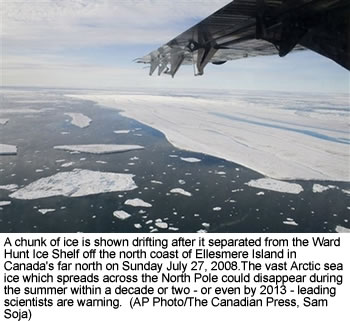Only a few years ago, climate modellers predicted the sea ice would not disappear in summer until at least the end of the century.
“Then they said 2070, and then they said 2050 and then they said 2030,” said Robie Macdonald, a leading Canadian oceanographer on board the Louis.
“Not only do I see the change, but it’s like they’re moving the goalposts toward me and it’s an amazing thing,” he said.
The team on board the Louis are some of the thousands of scientists from 60 nations working to draw attention to the rapid changes in the Arctic and Antarctic during International Polar Year.
The icebreaker’s route took us through thick sea ice at the entrance to the fabled Northwest Passage where over the centuries many navigators perished, most famously Sir John Franklin, a former governor of Tasmania.
Last year the Northwest Passage was virtually ice free for the first time in memory when the Arctic sea ice shrank to its lowest level since satellite observations began.
The US Interior Secretary, Dirk Kempthorne, announced in May the drastic loss of Arctic sea ice had forced him to list the polar bear as an endangered species because their populations could collapse within a few decades.
Hopes the sea ice would return to robust levels after last year’s record low are unlikely to be realised, according to the latest figures from the US National Snow and Ice Data Centre. While this year’s melt is not expected to shatter last year’s record, the sea ice is already significantly below average as the melt season peaks.
“We might see an ice-free Arctic Ocean by the year 2030 - within some of our lifetimes,” said Mark Serreze, a geographer at the snow and ice data centre.
“There are some scientists out there who think that even might be optimistic.”
The loss of the sea ice in summer would be unprecedented in human history, said Don Perovich a geophysicist with the US Army’s Cold Regions Research and Engineering Laboratory.
“As near as we can tell looking at the historical record, there’s been ice in the Arctic in the summer for at least 16 million years,” he said.
“There’s a group that makes a very strong case that in 2012 or 2013 we’ll have an ice-free [summer] Arctic - as soon as that. It’s astounding what’s happened,” said Dr Ted Scambos, a glaciologist from the snow and ice data centre.
The melt is leading Arctic nations, including Canada, Russia and the US, to seriously examine new shipping routes through the Arctic - including the Northwest Passage - and the potential expansion of huge oil and gas fields.
“As the ice recedes, it’s opening up not only the Arctic passage but all the resources in the Arctic Ocean,” said Scott Borgerson, from the US Council on Foreign Relations.
Last year’s melt was produced by a “perfect storm” of natural weather patterns and rising temperatures in the Arctic caused by global warming. The Arctic is warming at twice the average rate of the rest of the planet and the sea ice is considered by many scientists to be crucial for monitoring the speed of global climate change.
The more the bright white sea ice melts, the more the dark Arctic Ocean absorbs sunlight, in turn melting more sea ice and feeding back into global warming.
The disappearance of the sea ice could have serious ramifications for the earth’s climate and weather patterns, scientists say, explaining it would be like leaving the refrigerator door open on the planet.
“We could think of the Arctic as the refrigerator of the northern hemisphere climate system,” Dr Serreze said.
“What we’re doing by getting rid of that sea ice is radically changing the nature of that refrigerator. We’re making it much less efficient. But everything is connected together so what happens up there eventually influences what happens in other parts of the globe.”
Scientists are rapidly working to understand how much the loss of the summer sea ice might change weather patterns amid fears it will cause extreme storms and rainfall in some regions and prolong drought in others.
“The Arctic really can feed back into the global climate system,” said Dr Macdonald, who has worked with the UN’s peak scientific body, the Intergovernmental Panel on Climate Change. “You know what happens when you get feedbacks - you get surprises and we don’t like surprises.”
The Louis’ ice specialist, Erin Clark, explained that much of the ice at the entrance to the Northwest Passage this July was “first-year ice”, frozen over just last year, and it would be prone to melting. The extent of this year’s melt will not be known until September and scientists are worried that with six weeks still left in the melt season, this thin first-year ice could be vulnerable to rapid loss.
“A race has developed between the waning sunlight and the weakened ice,” the report of the national snow and ice data centre for the end of July explains.
Despite a colder winter in parts of the Arctic and cooler temperatures in late July, the size of the sea ice is expected to shrink to levels close to the second or third lowest on record by September, according to the centre.
Researchers are trying to understand how much of the melting is due to the extreme natural variability in the northern polar climate system and how much is due to global warming caused by humans. The Arctic Oscillation climate pattern, which plays a big part in the weather patterns in the northern hemisphere, has been in “positive” mode in recent decades bringing higher temperatures to the Arctic.
Dr Igor Polyakov, an oceanographer from the International Arctic Research Centre in Fairbanks, Alaska, explained that natural variability as well as global warming is crucial to understanding the ice melt. “A combination of these two forces led to what we observe now and we should not ignore either forces” he said.
The consensus among scientists is that while the natural variability in the Arctic is an important contributor to climate change there, the climate models cannot explain the rapid loss of sea ice without including “human-induced” global warming. This means human activity such as burning fossil fuels and land clearing which are releasing greenhouse gases in the atmosphere.
“There have been numerous models run that have looked at that and basically they can’t reproduce the ice loss we’ve had with natural variability,” said Dr Perovich. “You have to add a carbon dioxide warming component to it.”
As the sea ice fails to recover, there are concerns it will become one of the “tipping points” pushing the planet to faster climate change.
A number of scientific papers are raising concerns that global warming, especially in the Arctic, will begin to thaw some of the vast areas of permafrost in the Arctic regions, especially in Siberia and Alaska.
If that happens infrastructure including roads, railways, bridges and pipelines could begin to collapse. More importantly, scientists say, it’s possible that large amounts of the carbon dioxide and methane that are trapped in the permafrost will be released into the atmosphere, producing another feedback that will increase global warming.
The Arctic is a sentinel of change, Dr Macdonald explained on board the Louis, and urged everyone to take notice. “We should care in the sense that what happens here is coming to us and sometimes, you know, a warning is a helpful thing to mobilise people,” he said.
“If it takes the iconic polar bear for people to say maybe we need to do something, that’s a good thing.”
Copyright © 2008 Fairfax Digital

